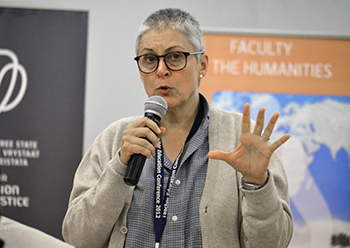
Prof Lis Lange believes universities have a critical
role to play in advancing democracy.
Photo: Thabo Kessah
In an attempt to promote common understanding on governance, leadership, and management processes at the University of the Free State (UFS), the Institute for Reconciliation and Social Justice (IRSJ) recently hosted a critical conversation on the Qwaqwa Campus that was facilitated by Vice-Rector: Academic, Prof Lis Lange.
Prof Lange’s presentation firstly focused on the role that universities play, and the expectations thereof.
“From ancient history, universities have always had a critical role to play in the broader society,” she said. “They have always been characterised by the circulation of knowledge and ideas at a global level. They have always ensured that students’ skills and knowledge are properly certified.”
According to her, universities have changed quite a bit over the centuries.
“Historically, universities used to cater for the chosen few, but they now allow multitudes to have access as well. In the early 20th century, women and foreigners, for example, were excluded. How they relate to the society has also changed. They also used to create certain types of knowledge – at one stage this knowledge was influenced by the church. Research is now produced across a large spectrum of human and scientific knowledge,” she said.
Prof Lange also added that universities now even have a responsibility to advance democracy and to respond to societal needs.
“Despite the various tensions and contradictions between management and academic staff, between management and students, and between academic staff and students, universities are now public spaces to exercise citizenship. They provide space for all to have the right to speak and to be heard. They provide space for all to have similar rights and responsibilities,’ she said, while breaking down all the governance, leadership and management structures of the UFS.
The conversation was concluded with a question and answer session, with students mainly asking about internal UFS processes.
The session was well received by students.
“I really loved the conversation, which to me, was about breaking the walls between the management and students so as to achieve the goal of an effective university. We need more of these dialogues,” said Noxola Tshabalala, a BA Psychology student.